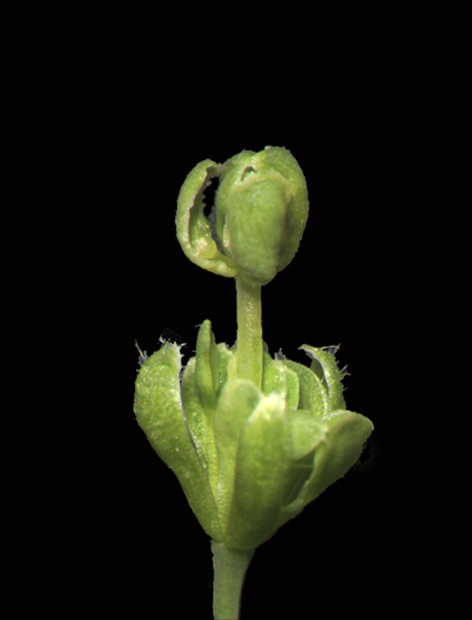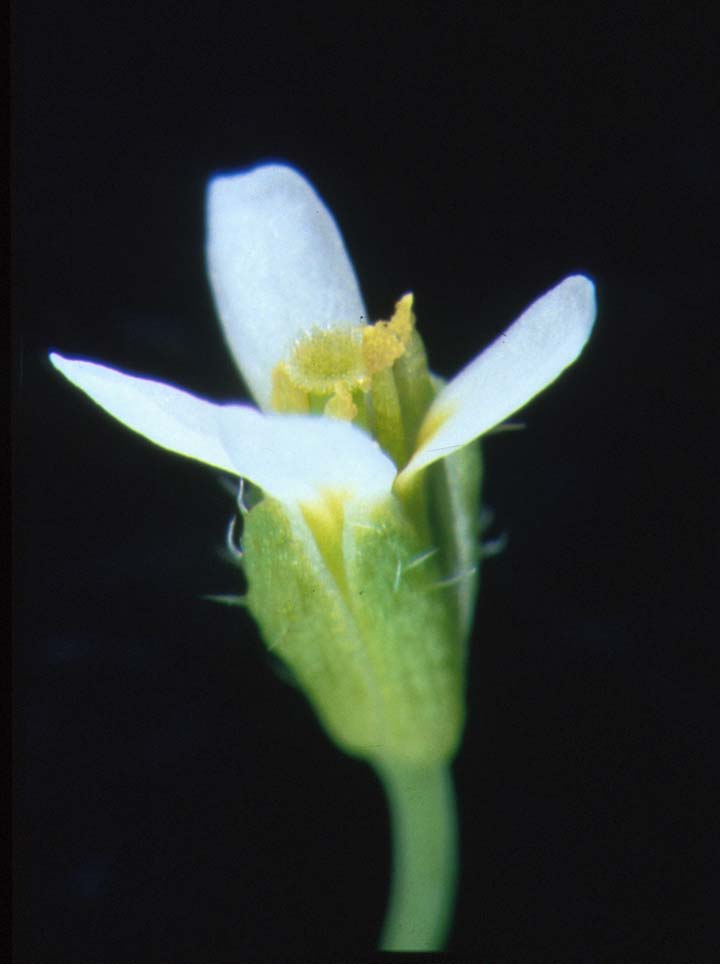Genes for Unusual "Flower Within a Flower" are Identified by UCSD Scientists
MAY 10, 2000
By: Kim McDonald
Gertrude Stein once wrote that a rose is a rose is a rose. But not all roses consist of mundane single flowers. One of the more unusual curiosities of the plant world—among roses and other flowers—is a flower within a flower within a flower.
The abnormality has long puzzled geneticists, who have sought for years in vain for the genes responsible for this condition. But an important part of the mystery has been solved by a team of biologists at the University of California, San Diego.
In a cover story in the May 11th issue of Nature, the scientists report that they have identified a trio of genes that produce this flower within a flower, one of the earliest-recognized abnormalities in flowers.
 |
First described more than 2,000 years ago and initially referred to as a "monstrous flower," the abnormality is now called the "double flower" and is prized within the flower industry for its attractiveness. Many roses, camellias and impatiens, as well as a host of other plants produce these double flowers, which are grown from plant cuttings because the plants, having lost their reproductive organs, are effectively sterile.
 |
Plants do not normally produce double flowers in the wild and, in their study, the UCSD biologists discovered why. Only when three virtually identical genes within the plant’s cells are all mutated, they found, is the result a flower within a flower within a flower, a repetitive process that continues indefinitely—or at least until the smallest organs of the flower can’t be detected.
"They endlessly reiterate flower organs, they just keep on going and going," says Martin F. Yanofsky, a professor of biology at UCSD who headed the research team, which included
UCSD biologists Soraya Pelaz and Gary S. Ditta. Elvira Baumann and Ellen Wisman of the
Max-Planck Institute for Breeding Research in Koln, Germany also participated in the study, which was financed by the National Science Foundation and the National Institutes of Health.
 Normal flowers consist of a series of four rings or "whorls." The outermost whorl is made up of sepals, the green leaf-like organ that normally surrounds the flower bud before it opens. Inside the sepals is a ring of petals, then a ring of stamens, the male reproductive structures, and at the center are the carpels (often referred to as the pistils), the female reproductive structures.
Normal flowers consist of a series of four rings or "whorls." The outermost whorl is made up of sepals, the green leaf-like organ that normally surrounds the flower bud before it opens. Inside the sepals is a ring of petals, then a ring of stamens, the male reproductive structures, and at the center are the carpels (often referred to as the pistils), the female reproductive structures.
When the three genes found by the UCSD scientists are all mutated, the petals, stamens and carpels are all converted into sepals, resulting in the double-flower character. "Because these genes are necessary for petals, stamens and carpels to form in a normal flower, they are master regulators of flower development," says Yanofsky.
The important role of these three genes had long been hidden from geneticists, because all three genes are virtually identical, meaning that the UCSD researchers had to mutate each one of these genes and then combine the three mutations into a single plant. This technique, referred to as "reverse genetics," took years of effort in the laboratory, but finally paid off in the discovery of the triple mutant in the weed plant, Arabidopsis, which has long been used as a plant model by geneticists.
"This was a heroic undertaking, as three genes had to be knocked out in order for the function to be revealed," says Detlef Weigel, an expert on flower development who is an associate professor at the Salk Institute for Biological Studies. "This paper will make it into the textbooks."
Botanists proposed hundreds of years ago that the sepal, petal, stamen and carpel organs that make up a typical flower represent modified leaves. But despite the rapid progress that many researchers around the world have made over the past decade in isolating key flower-control genes, they have not been able to convert leaves into each of the flower organs.
"This discovery may add the missing piece of the puzzle, as we now know that these genes are necessary for the formation of the different flower organs," says Yanofsky. "It will now be interesting to directly test this idea by turning on these genes in leaves, where they are normally turned off. This could well make for some very interesting new plant varieties that have, for example, colorful petals replacing the normal leaves."
